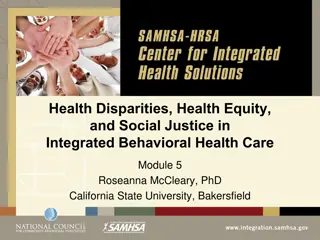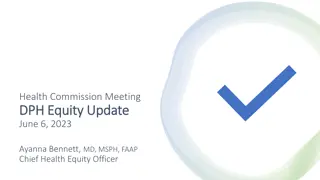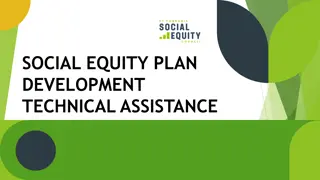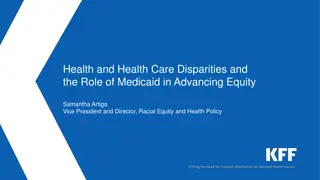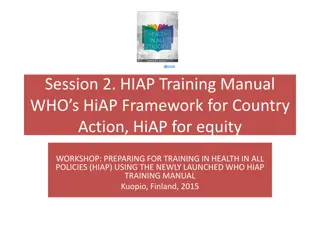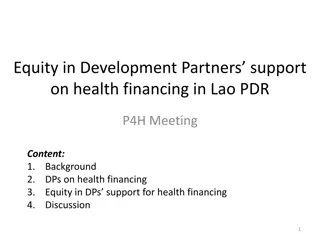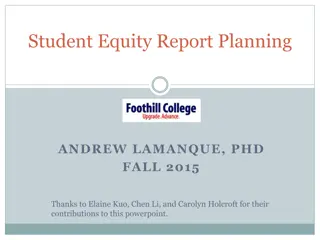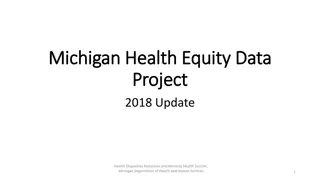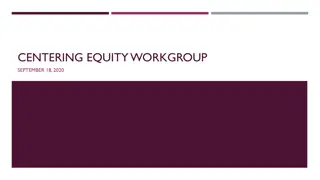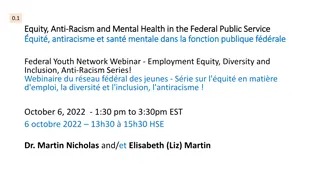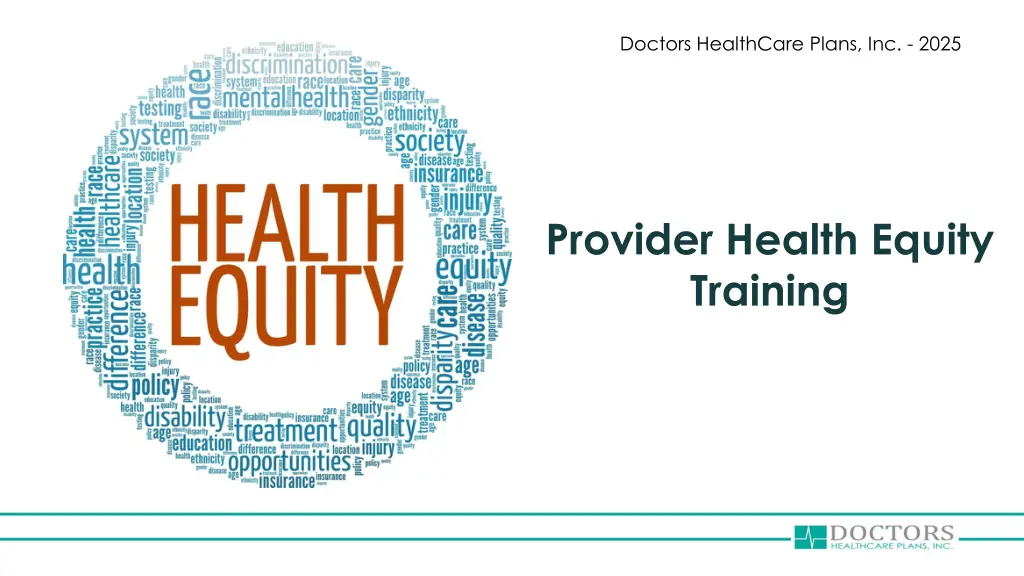
Advancing Health Equity: DHCP Training Highlights and Initiatives
Explore Doctors.HealthCare.Plans,.Inc.'s (DHCP) Health Equity Training focusing on key elements of their Health Equity Plan (HEP) to foster a community rooted in Diversity, Equity, and Inclusion. Discover how DHCP aligns with CMS, HHS, and Healthy People 2030 Framework to reduce disparities and promote health equity among underserved populations. Learn about the impact of Social Determinants of Health, actions taken to address health disparities, and the importance of Advanced Care Planning in achieving health equity.
Download Presentation

Please find below an Image/Link to download the presentation.
The content on the website is provided AS IS for your information and personal use only. It may not be sold, licensed, or shared on other websites without obtaining consent from the author. If you encounter any issues during the download, it is possible that the publisher has removed the file from their server.
You are allowed to download the files provided on this website for personal or commercial use, subject to the condition that they are used lawfully. All files are the property of their respective owners.
The content on the website is provided AS IS for your information and personal use only. It may not be sold, licensed, or shared on other websites without obtaining consent from the author.
E N D
Presentation Transcript
Doctors HealthCare Plans, Inc. - 2025 1 Provider Health Equity Training
Purpose 2 The purpose of this training is to share key elements of Doctor s HealthCare Plans, Inc. (DHCP) Health Equity Plan (HEP) and how they contribute to our ongoing growth by fostering a community rooted in Diversity, Equity, and Inclusion. By the end of this training, you will understand: The definitions of Health Equity, Health Inequity, and Health Disparity, and how these concepts influence individuals and their well-being. The impact of Social Determinants of Health (SDOH) on the health of individuals and our community. The actions DHCP is taking to identify, mitigate, and address potential health disparities and inequalities.
Aligning with CMS and HHS 3 The United States has made progress towards improving health care quality, but well- Advanced Care Planning (ACP) documented disparities persist for members of racial and ethnic communities, people with disabilities, members of the LGBTQ+ community, individuals with limited English proficiency, members of rural communities, and persons otherwise adversely affected by persistent poverty or inequality. 1,2,3 What is it? A. A voluntary, face-to-face service (telehealth also counts), between a physician or other qualified health care professional (QHP) and a patient, family member, caregiver or surrogate to discuss the patient s health care wishes if they become unable to make their own medical decisions. DHCP Health Equity Plan has been created in a manner that aligns with the HHS and CMS initiatives that seeks to achieve health equity and reduce disparities among minority and the underserved populations. This includes the Health People 2030 Framework, 4 which establishes the foundational principle that achieving health and well-being requires eliminating health disparities, achieving health equity, and attaining health literacy. Purpose B. To help adults at any age or stage of health understand and share their personal values, life goals and preferences regarding future medical care. It is not a single decision, it is a process that involves a variety of steps. References: 1. Health Equity Considerations and Racial and Ethnic Minority Groups. Centers for Disease Control and Prevention. Published February 11, 2020. https://www.cdc.gov/coronavirus/2019-ncov/community/health-equity/race- ethnicity.html 2. Disability and Health. HealthyPeople.gov. https://health.gov/healthypeople/objectives-and-data/browse-objectives/people-disabilities 3. Krahn GL, Walker DK, Correa-De-Araujo R. Persons with disabilities as an unrecognized health disparity population. Am J Public Health. 2015;105 Suppl 2(Suppl 2):S198-S206. doi:10.2105/AJPH.2014.302182 4. Healthy People 2030. U.S. Department of Health and Human Services Office of Disease Prevention and Health Promotion. https://health.gov/healthypeople
DHCP Framework for Health Equity 4 Consistent with CMS s and Healthy People s 2030 Framework for Health Equity, the DHCP Health Equity Plan sets priorities to strengthen infrastructure for assessment, create synergies across health care systems, drive structural change, and identify and work to eliminate barriers to benefits, services, and coverage.
DHCP Health Equity Priorities 5 Consistent with CMS priorities, the DHCP Health Equity Plan s Top 5 priorities include: Priority 1: Expand the collection, reporting, and analysis of standardized Health Equity related member and provider data. Priority 2: Assess causes of disparities within the plan, and address inequities in policies and operations to close gaps. Priority 3: Build capacity of the plan and workforce, including our network providers, to reduce health and health care disparities. Priority 4: Advance language access, health literacy, and provision of culturally appropriate services specific and unique to the population we serve. Priority 5: Increase all forms of accessibility to health care services and coverage. For additional information related to the above priorities and DHCP related initiatives, please refer to the Plan s Health Equity Program located at www.doctorshcp.com.
Health Equity, Disparities & Inequalities Health Equity Health Disparities Health Inequities The attainment of the highest level of health for all people, where everyone has a fair and just opportunity to attain their optimal health regardless of race, ethnicity disability, sexual orientation, gender identity, socioeconomic status. geography, preferred language, and other factors that affect access to care and health outcomes. Preventable differences in the burden of disease, injury, violence, or opportunities to achieve optimal health, health quality, or health outcomes that are experienced by underserved populations. Systematic differences in health outcomes. They are differences in health status or in the distribution of health resources between different population groups, arising from the social conditions in which people are born, grow, live, work and age. Social Determinants of Health ( SDOH ) arethe conditions in the environments where people are born, live, learn, work, play, worship, and age that affect a wide range of health, functioning, and quality-of-life outcomes and risks. References: www.cms.gov/files/document/health-equity-fact-sheet.pdf www.cdc.gov/aging/disparities https://health.gov/healthypeople/priority-areas/social-determinants-health
Underserved Communities The term underserved communities refers to populations sharing a particular characteristic, including geographic communities that have been systematically denied a full opportunity to participate in aspects of economic, social, and civic life, as exemplified in the definition of equity. This includes members of racial and ethnic communities, people with disabilities, members of the lesbian, gay, bisexual, transgender, and queer (LGBTQ+) community, individuals with limited English proficiency, members of rural communities, and persons otherwise adversely affected by persistent poverty or inequality. The Department of Health and Human Services (HHS) characterizes underserved, vulnerable and special needs populations as communities that include members of minority populations or individuals who have experienced health disparities, which are listed below: Latino, African American and AI/AN populations Refugees Individuals with limited English proficiency (LEP) Young adults and postsecondary graduating students who do not have health coverage options through a parent s plan, student plan or employer plan New mothers and women with children Individuals with disabilities Medicaid-eligible consumers who are not enrolled in coverage despite being eligible for Medicaid
Social Determinants of Health Overview 9 What Impacts Our Health? Advanced Care Planning (ACP) Our health is determined in part by the: Access to social and economic opportunities Resources and supports available in our homes, neighborhoods, and communities Quality of our schooling Safety of our workplaces Cleanliness of our water, food, and air Nature of our social interactions and relationships What is it? A. A voluntary, face-to-face service (telehealth also counts), between a physician or other qualified health care professional (QHP) and a patient, family member, caregiver or surrogate to discuss the patient s health care wishes if they become unable to make their own medical decisions. Purpose B. The conditions in which we live explain in part why some Americans are healthier than others and why Americans in general are not as healthy as they could be. To help adults at any age or stage of health understand and share their personal values, life goals and preferences regarding future medical care. It is not a single decision, it is a process that involves a variety of steps.
Social Determinates of Health (SDOH) -5 Domains 10 1. Economic Stability Challenges: Lack of steady employment and sufficient income impacts the ability to afford essentials like healthy food, healthcare, and housing, leading to health disparities. Interventions: Employment programs, career counseling, and support for basic needs (food, housing, healthcare) can reduce poverty and improve health. 2. Education Access and Quality Challenges: Children from low-income families, with disabilities, or facing discrimination often struggle academically, are less likely to graduate, and are more prone to health issues. Interventions: Supporting children in school and providing financial assistance for college can lead to long-term health benefits. 3. Health Care Access and Quality Challenges: Uninsured individuals often lack access to primary care and necessary health services, leading to untreated conditions and delayed care. Interventions: Increasing insurance coverage, improving access to healthcare providers, and enhancing digital health literacy can improve health outcomes. 4. Neighborhood and Built Environment Challenges: Living in unsafe neighborhoods with environmental risks contributes to health problems, particularly among racial/ethnic minorities and low-income populations. Interventions: Policy changes, adding sidewalks, and ensuring safe biking paths can enhance community health and safety. 5. Social and Community Context Challenges: Relationships and interactions within one s community can significantly impact health. Negative environments exacerbate health risks. Interventions: Providing social and community support can help mitigate these challenges and promote overall well-being.
Personal Health Literacy 11 Advanced Care Planning (ACP) skills to access and understand health information and services in order to improve and maintain health. These skills include: Reading & writing Calculating numbers Communicating with health care professionals Using health technology Listening, speaking & critical analysis Decision-making skills Personal health literacy is the ability to use a variety of Research has shown that health literacy can: Increase the use of preventive health care Lower unneeded emergency room visits Lower preventable stays in the hospital and readmissions Lower dosing errors Help patients better manage their chronic conditions such as diabetes, high cholesterol, hypertension, and HIV/AIDS Improve health outcomes Enhance all six aims of quality improvement: safe, effective, patient-centered, timely, efficient, and equitable Increase patient satisfaction What is it? A. A voluntary, face-to-face service (telehealth also counts), between a physician or other qualified health care professional (QHP) and a patient, family member, caregiver or surrogate to discuss the patient s health care wishes if they become unable to make their own medical decisions. Purpose Apply the health information rather than just understand it. Make well-informed decisions rather than appropriate ones. The ultimate goal for DHCP members is to: B. To help adults at any age or stage of health understand and share their personal values, life goals and preferences regarding future medical care. It is not a single decision, it is a process that involves a variety of steps.
Organizational Literacy How Providers Can Help 12 Advanced Care Planning (ACP) Organizational health literacy is the degree to which organizations equitably enable individuals to find, understand, and use information and services to inform health-related decisions and actions for themselves and others. What is it? How Providers can help: Incorporate SDOH questions into health assessments and refer DHCP members, with identified gaps, to DCHP Social Services Department for assistance. Document SDOH Gaps in member encounters utilizing appropriate ICD-10 Z codes. Inform members about your office telemedicine policy, assuring members are aware of the accessibility of telehealth services and are provided instructions for accessing telehealth services when needed. Assure that all staff provide medical care in a manner that considers the member s race/ethnicity, language and cultural preferences which may impact/influence their health care outcomes. Ensure office staff have access to and undergoes cultural sensitivity training and development. Offer assistance with completing forms. When developing treatment plans, consider the member s race, country of origin, native language, religion, mental and physical abilities, cultural beliefs, age, gender, sexual orientation and other characteristics that may impact/influence a member s perspective on healthcare and treatment options. Post materials in English, Spanish and other prevalent languages to accommodate the members linguistic preference. A. A voluntary, face-to-face service (telehealth also counts), between a physician or other qualified health care professional (QHP) and a patient, family member, caregiver or surrogate to discuss the patient s health care wishes if they become unable to make their own medical decisions. Purpose B. To help adults at any age or stage of health understand and share their personal values, life goals and preferences regarding future medical care. It is not a single decision, it is a process that involves a variety of steps. https://www.hrsa.gov/about/organization/bureaus/ohe/health-literacy



